SILQ Barrister: Australia’s leading software for barristers. SILQ takes care of your business so you can spend more time on your business. Available on both Mac and PC
|
Download a FREE trial of a fully-functional version of SILQ Barrister.
|
|
|
| |
“When I started at the bar, my wise and insightful junior master gave me three tips: The first was ‘A judge’s joke is always funny’; the second: ‘no matter how hard, resist the temptation to refer to the UNCITRAL model law in every advice’ and the third was ‘get SILQ’.”
– Jo Chapple, QLD more …
“SILQ is indispensable in my private practice as a barrister. SILQ saves me time and money, and gives me unparalleled control over my practice and accounts. I would not dream of practising without it.
– Philippe Doyle Gray, NSW more …
“SILQ gives me complete control of my financials, and assists me to capture significantly more chargeable time. It therefore pays for itself many times over every year.”
– John Oswald-Jacobs, VIC more …
|
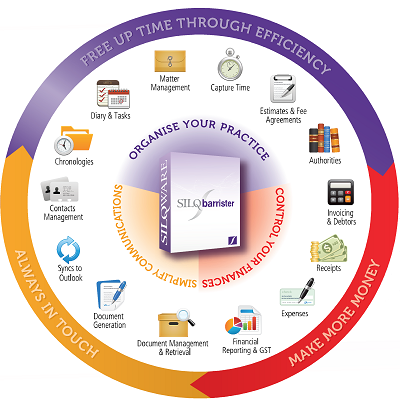 |
| SAVE TIME |
MAKE MORE MONEY |
TAKE CONTROL |
EASY TO USE |
SILQ takes care of the tedious administrative tasks you would otherwise spend hours on every week.
- Access all your matter and contact details in the one place.
- Automate document generation with your own, customisable letterhead and font (invoices, cost disclosures, cost agreements, chaser letters, faxes).
- Easily comply with Australian legislative requirements.
- Assess and report GST clearly, accurately and instantly.
|
SILQ is built around time costing so all your time can be billed — increasing your profit.
- Allows you to manage your business with minimal administrative support.
- Capture every minute with electronic time-entry.
- Issue invoices faster with automated document generation.
- Identify outstanding invoices at a glance; then generate chaser letters instantly.
- Reduce accounting and bookkeeping fees with streamlined reporting.
|
SILQ creates and tracks all financial and administrative tasks in one simple and easy-to-use environment.
- Quickly and easily generate graphs and reports to give you a clear overview of your business.
- Evaluate your financial situation instantly; the work you’re doing, completed, billed and received.
- Automatically organise and store documents relating to any and every matter.
- Anticipate tax confidently, lodge BAS punctually and easily deal with end-offinancial year accounts.
|
SILQ’s layout is very user friendly and intuitive. If you need support, you’ll be speaking directly with a local expert who will guide you.
- SILQ has been designed from the ground up specifically for barristers by barristers.
- Since its launch in 2003, SILQ has been regularly upgraded based on feedback from some of the many hundreds of Australian barristers using the software.
- The user-interface has been designed for speed and simplicity.
|
Download a FREE trial of a fully functional version of SILQ Barrister.
|
 |
For more information phone us on 1300 556689
|
Sexual Assault: huge challenges and innovative responses
11 October 2011
Only a fraction of sexual assaults are reported to police. And of those that are reported only 11.5% result in a conviction.
Why are the figures so low? And is it time to move beyond criminal prosecutions in all cases?
In some cases might it be appropriate to have the victim and perpetrator talk through the issues face to face?
It’s a radical idea, and it’s coming from some surprising quarters.
Listen
The Racial Discrimination Act: Eatock v Bolt
4 October 2011
Freedom of expression versus the right not to be racially abused.
Last week the Federal Court found that Herald Sun columnist Andrew Bolt breached the Racial Discrimination Act when he wrote that a number of light-skinned Aboriginal people chose an Aboriginal identity in order to further their careers.
A slap in the face for freedom of expression, or sensible response to an offensive racial slur?
Listen
 Audio evidence in court cases
27 September 2011
Scratchy voice recordings are often put before juries, especially in drug and terrorism cases. It’s important evidence but how can we avoid the pitfalls?
How can we avoid jurors being primed into thinking they hear something that simply isn’t there?
On the Law Report, take an experiment and find out if you’re ears are ‘jumping the gun’.
Listen
Triple trouble for Charter true believers
20 September 2011
Is it the end of the line for Victoria’s Charter of Human Rights and Responsibilities?
A parliamentary committee is recommending the dumping of court oversight.
Meanwhile a court decision involving a Somali refugee evicted from public housing confirms that tribunals can’t hear Charter arguments.
And a High Court decision involving a lawyer convicted of drug trafficking makes it clear a Victorian style scheme could never operate on a national level.
Listen
The Chief Justice of Canada Beverley McLachlin
13 September 2011
Name this country: it’s a geographically giant federation, sparsely populated, resource rich, with strong legal traditions inherited from the British.
Answer? Canada. Coming up on the Law Report a conversation with Beverley McLachlin, the Chief Justice of the Supreme Court of Canada. A look at federation, freedoms, and formulas for appointing judges in the Great White North
Listen
Introducing the Mercedes-Benz Corporate Programme for Queensland Bar Association members.
When you own a Mercedes-Benz, you become a part of a culture of excellence. It’s what defines us and makes us a leader in our field… and it’s not just our vehicles that make us shine.
We’re also good at engineering some great benefits for companies and associations recognized as leaders in their field.
That’s why all Queensland Bar Association members automatically qualify for the Mercedes-Benz Corporate Programme when purchasing a new vehicle from Mercedes-Benz Brisbane. We provide all Bar members a number of significant benefits including the following:
- Preferential pricing on new vehicles and options;
- Reduced Dealer Delivery Fee including complimentary carpet floor mats;
- Complimentary scheduled servicing at authorised Mercedes-Benz dealerships for 3 years or 75,000km (whichever comes first)*;
- Complimentary pick-up and drop-off, or access to a loan vehicle when your Mercedes-Benz is being serviced; and
- Total of 4 years
With 18 models available, and numerous variations, you’re bound to find your dream car.
For more information contact our Corporate Sales Manager at Mercedes-Benz Brisbane, Christopher Tapp on 07 3251 6666.
*kilometres covered vary for AMG and V12 product, please confirm with Mercedes-Benz Brisbane

News, views, Practice Directions, events, forthcoming national and international conferences, CPD seminars and more …
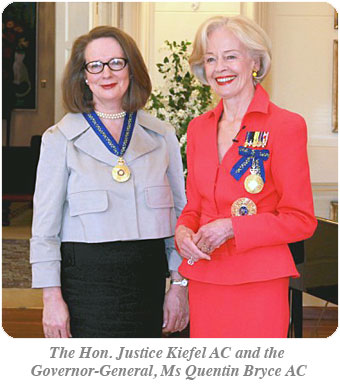 The Honourable Justice Kiefel awarded an AC
The Honourable Justice Kiefel awarded an AC
On 5 October 2011 the Governor-General, as Chancellor of the Order of Australia, invested The Hon. Justice Susan Kiefel with Companion of the Order of Australia (AC). Her Honour was awarded an AC in the Queen’s Birthday Honours list for eminent service to the law and to the judiciary, to law reform and to legal education in the areas of ethics, justice and governance.
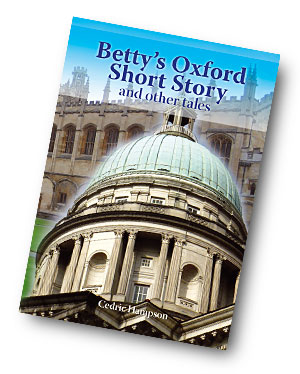 Book Launch – Betty’s Oxford Short Story and other tales by Cedric Hampson
Book Launch – Betty’s Oxford Short Story and other tales by Cedric Hampson
You are invited to attend the official launch of Cedric Hampson’s latest literary work Betty’s Oxford Short Story and other tales. The event will take place on Thursday 27 October 2011Â from 5:30 – 6:30 p.m. in the Banco Court. The evening will feature The Honourable Justice Glenn Martin as MC and Chris Nyst, Lawyer, Author, Film Maker as Guest Speaker.
Please RSVP by Monday October 24 by email: pr@cedrichampson.com or telephone: 5492 4921
Overview
Prolific writer Cedric Hampson brings his masterful talent as a storyteller to these 24 stories of intrigue and suspense.
His writing is characterised by a brooding intensity, whether it be tales of courtroom drama, or of suffering and human despair.
Betty’s Oxford Short Stories and other tales tells of how man realises his ambition without knowing how he affects others.
The Birthday Present is written from the point of view of a child, sadly describing the breakup of her parents. Aunty Audry and Hedda are bittersweet in taste while the Visit by the Sons of Nippon is a short brutal tale.
All stories are individualistic, a writer of keen perception and visualisation, Hampson has often been praised for the distinctiveness of his character vignettes.
Reviews
For more than forty years Cedric Hampson had few peers in the law. His incisive intellect, fearless advocacy, and unquestioned integrity made him an outstanding leader of the legal profession he so ably served. At the same time he remained always the Renaissance Man, a true humanist whose talents as a scholar, writer and artist, intrinsically informed every facet of his character, his work, and his personal, professional, and social interaction.
Cedric Hampson’s delightfully unaffected short stories reflect a lifetime lived at the climactic edge of human interaction. The one-time courtroom maestro brings the heartfelt empathy of a passionate advocate to these simple tales of human turmoil. By turn tragic, intriguing, and utterly heart-warming, they are a joy to read.
Chris Nyst – Lawyer, Author, Filmaker
Cedric Hampson is an artist whose medium of choice is the word rather than the brush. He paints vivid scenes that entice us to venture into the world of his characters and share the sights, sounds and smells of their surroundings. Cedric’s distinguished career at the bar brings a lifetime of experience and an attention to detail to his writing. A keen observer of humanity, his diverse characters do not present as figures of fiction, but rather as flesh and blood. We recognise them. We share their emotions and they speak to us.
The Honourable Dr David Hamill AMÂ
STEP Qld Trust and Succession Law Conference
The Inaugural STEP Qld Trust and Succession Law Conference held on Friday 2011 at the Shangri-La Hotel in Cairns could not have been more successful, according to Queensland Branch Chair Caite Brewer.
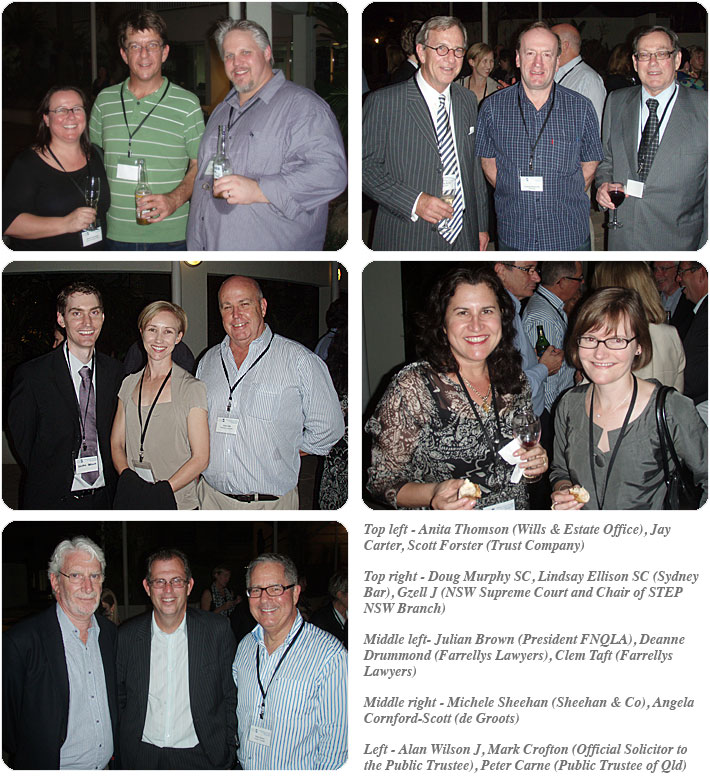 Delegates from as far away as Tasmania and South Australia commented enthusiastically on the relaxed atmosphere, interesting technical papers, experienced speakers, networking opportunities, and the superb location.
Delegates from as far away as Tasmania and South Australia commented enthusiastically on the relaxed atmosphere, interesting technical papers, experienced speakers, networking opportunities, and the superb location.
Social functions on Thursday and Friday evenings were friendly and relaxed as practitioners from across the state met and engaged in vigorous discussion regarding succession law practice.
Ms Brewer said that the Queensland branch of STEP is proud to have the greatest number of members of all Australian branches, having re-launched the branch in May 2010.
Following the outstanding success of the conference, the STEP Qld committee is already planning future events.
10th Annual Clayton Utz International Arbitration Lecture
The 10th annual Clayton Utz International Arbitration lecture will be given by Essam Al Tamimi on Tuesday, 8 November 2011. Supported by the University of Sydney, the event will be held in the Ceremonial Court of the Federal Court in Sydney and will be presented by video link at Federal Courts in Brisbane, Melbourne, and Perth, as well as being streamed online.
The topic of this year’s lecture is Islamic Influences on International Arbitration. Renowned international arbitrator Essam Al Tamimi will focus on:
- Is there scope for Sharia in international arbitration?
- To what extent is Sharia applicable to international arbitration, either directly or through modern laws?
- Can Sharia be considered as equivalent to the equitable law and the general rules of law and justice that are often applied by arbitrators in international arbitration?
Details
Date: 8 November 2011
Time: 4:00pm
Venue: Brisbane Federal Court Court 1, Level 7 Harry Gibbs Commonwealth Law Courts Building 119 North Quay
Please register by Monday, 24 October 2011 by contacting Samantha Wakefield by phone: (02) 9353 4297 or email: swakefield@claytonutz.com
Participation will enable you to collect one CLE point.
WA Lee Equity Lecture 2011
Thursday 17 November – Banco Court
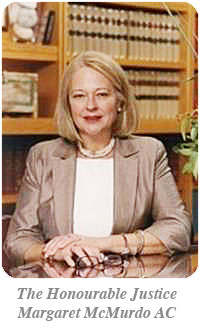 QUT is proud to host the 2011 WA Lee Equity Lecture. The Hon Justice Margaret McMurdo AC, President of the Court of Appeal, will be presenting the lecture. The Chief Justice The Hon. Paul de Jersey AC will be chairing the evening.
QUT is proud to host the 2011 WA Lee Equity Lecture. The Hon Justice Margaret McMurdo AC, President of the Court of Appeal, will be presenting the lecture. The Chief Justice The Hon. Paul de Jersey AC will be chairing the evening.
The WA Lee Equity Lecture is held each year in honour of foremost equity and trusts academic and author, Professor Tony Lee. This Lecture is organised by the Faculty of Law in collaboration with the QUT Centre for Philanthropy and Non-Profit Studies and the Queensland Community Foundation.
About the Topic
For the 2011 WA Lee Equity Lecture, Justice McMurdo’s topic is Faith, Hope and Charity: The Resilience of the Charitable Trust From the Middle Ages to the 21st Century.
Her Honour will briefly examine the origin and history of trusts, with a primary focus on charitable trusts. The evolving concept of the notion of charity since the seminal preamble to the Statute of Elizabeth 1601 will then be analysed. Justice McMurdo will then address aspects of the law in Queensland pertaining to that resilient entity, the charitable trust, before discussing its present and future relevance and areas where law reform may be necessary.
About The Honourable Justice Margaret McMurdo AC
Since 2008 her Honour has chaired the Advisory Board to the Institute for Ethics and Governance and Law. She is a foundation fellow of the Australian Academy of Law. She holds honorary degrees from QUT and GU, has been a member of the Zonta Club of Brisbane for over 30 years and is a co-patron of the Indigenous school, Hymba Yumba, and a patron of the Grey Man, an international charity fighting the exploitation and trafficking of children. In 2007 she was awarded the Companion of the Order of Australia. Her other achievements include:
â¢Assistant Public Defender – 1978 to 1989
â¢Â Brisbane Girls Grammar School Trustee – 1994 to 1998
â¢Â QUT Faculty of Law Advisory Committee Member – 1991 to Present
â¢Â President of the Queensland Court of Appeal – 1998 to Present
â¢Â Griffith University Council Member – 2003 to Present
Details
Date: Friday, 17 November
Time: 5:30pm for 6:00pm
Location: Banco Court
Further Enquiries: email rsvplaw@qut.edu.au or call 3138 5208
CPD Points : Attendees may claim one CPD point for this lecture
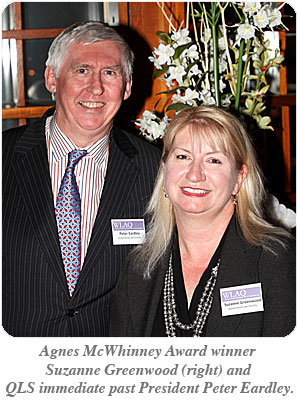 Not-for-profit lawyer achieves great things
Not-for-profit lawyer achieves great things
The Queensland Law Society Agnes McWhinney Award was recently presented to seasoned not-for-profit lawyer Suzanne Greenwood for her significant career of achievements.
Presented as part of the Woman Lawyers Association of Queensland’s 2011 Awards Dinner on Friday 9 September, Queensland Law Society CEO Noela L’Estrange said the award recognised Suzanne’s commitment to addressing social issues within the community.
“Suzanne is a credit to the profession, being General Counsel for St Vincent de Paul Queensland and actively involved in Epilepsy Queensland Inc. for more than 15 years.
“She initially provided pro bono legal services for Epilepsy Queensland Inc. and is now Chairman of their Board,” Ms L’Estrange said.
“Her commitment to the community also extends to being a member of Queensland Health’s Human Research Ethics Committee.”
The annual Agnes McWhinney Award is named for Australia’s first female solicitor, admitted in Townsville in 1915.
Other awards presented at the Woman Lawyers Association of Queensland’s 2011 Awards Dinner included:
- Woman Lawyer of the Year 2011: Teresa Dyson
- Regional Woman Lawyer of the Year 2011: Di Turner
- Emergent Woman Lawyer of the Year 2011: Diane Ruhl.
Business and Human Rights Seminar
Mallesons Stephen Jaques and the QUT Faculty of Law will be holding their inaugural Business and Human Rights seminar on 31 October 2011. The title of this year’s seminar is “The Right Path for Business”.
Professor Bryan Horrigan will provide his perspective on the topic in a seminar which will give practical insights into:
â¢Â how human rights relate to business
â¢Â how business can integrate human rights and corporate social responsibility in corporate governance
â¢Â what a company should consider in relation to human rights in multiple due diligence contexts
This seminar will also explore the significance and consequences of recent international developments in this area, including the UN Human Rights Council endorsing Professor John Ruggie’s “Guiding Principles on Business and Human Rights”. These developments have further encouraged stakeholders to look at the effects of human rights on business both within Australia and overseas.
Professor Bryan Horrigan
Professor Bryan Horrigan is the Louis Waller Chair of Law and Associate Dean (Research) at Monash University, and a long-standing legal and governmental consultant in public and corporate law and governance. He is the author of the recent internationally published book Corporate Social Responsibility in the 21st Century: Debates, Models and Practices Across Government, Law and Business.
Details:
Date: Monday 31 October 2011
Time: 12.45pm for 1.00pm – 2.00pm
Venue: Mallesons Stephen Jaques, Level 30 Waterfront Place, 1 Eagle Street, Brisbane
A light lunch will be served
RSVP to rsvplaw@qut.edu.au
Child and Adolescent Forensic Mental Helath Conference
The Royal Australian and New Zealand College of Psychiatrists (RANZCP) Faculty of Child and Adolescent Psychiatry and Faculty of Forensic Psychiatry are delighted to present this event which will take place in the historic harbour-side setting of The Rocks, Sydney.
The event will be held over a five day period from Tuesday 8 to Saturday 12 November 2011 at the Shangri-La Hotel, Sydney and will include a three day workshop (8-10 November 2011) and a two day conference (11-12 November 2011).
An exciting and diverse scientific program will be headlined by a keynote presentation from Professor Susan Bailey who will be joined by her colleague Ms Maeve Murphy, Clinical Nurse Specialist, FACTS Team, Adolescent Forensic Service and other speakers in what will be an intriguing scientific program with wide appeal.
Opportunities to relax and enjoy the company of friends and colleagues old and new will be provided courtesy of the conference dinner, which will take place on the evening of Friday 11 November 2011.
For registration and further information please visit the website.
A lighter moment in the practice of law
The relationship of trust between a barrister and their instructing solicitor is sacrosanct. After all the law is a serious business (well not always).
(Only the names have been changed to protect the guilty)
The Complaint – The need for Bear essentials
Dear Ahab,
Apart from the absence of a bear riding a small tricycle, the circus of the Simpson matter once again lumbered into town.
I appeared to protect your virtue of course. Mr. C appeared on behalf of Mr & Mrs G. Mr. B was to appear via telephone on behalf of Fred, but he missed the train and the circus rolled on without him.
The star of the show, the sister appeared in person via telephone. Of course his Honour was less than impressed with the fact that as captain of the sinking vessel, the matter was unlikely to be determined with the expeditious efficiency once contemplated by His Honour.
….
The sister as per usual was conservative with the information that she provided to the Court as to her living circumstances. This of course did not go down well with his Honour and following some reminisces as to the state of the evidence at trial by yours truly, His Honour ordered that the sister provide an affidavit outlining her circumstances including the reasons for her move, her living arrangements and her proposals.
As a result of further whingeing on my part it was also ordered that the sister’s “housemate”’ provide an affidavit as to his circumstances. This appeared necessary as the sister suggested that he was not a person who she was in a relationship with. This was of course the infamous “Chewbacca defence” which the sister had already played unsuccessfully at trial regarding her last friend Bert.
….
His Honour’s temperament was not assisted by the sister’s death knell interjection as to what orders should be made for her. It was at this point, that the bear with the tricycle should have been dispatched, but alas as you have failed to brief me with the same I could not deploy said bear.
….
As fun as this outing was, I am still hopeful of getting paid and should be grateful if you could forward some form of legal aid proforma.
Regards
Nemo
Barrister-at-law
13.8.2010
The Response
Dear Nemo

Never let it be said that I leave any stone unturned in providing my instructions.
The Supreme Court History Program Yearbook 2010 Now Available
The Supreme Court History Program Yearbook, now in its sixth year of publication, has proven a valuable addition to the libraries of historians and lawyers alike. As the only publication of its kind in Queensland, the Yearbook features scholarly articles on Queensland’s legal history, together with tributes to retiring judges, legal personalia and a review of significant judicial and legislative developments for the year. This volume serves as a significant resource for those seeking an overview and enduring record of the Queensland legal profession in 2010.
Download the order form here.
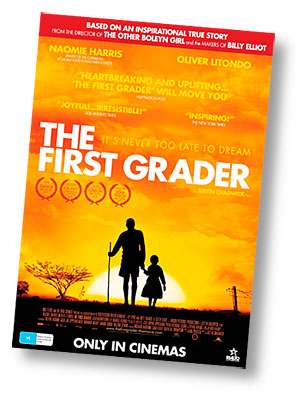 Film Release – The First Grader
Film Release – The First Grader
Directed by Justin Chadwick, The First Grader will be released on 17 November 2011.
Synopsis: In a small, remote mountain top primary school in the Kenyan bush, hundreds of children are jostling for a chance for the free education newly promised by the Kenyan government.
One new applicant causes astonishment when he knocks on the door of the school. He is Maruge (Oliver Litondo), an old Mau Mau veteran in his eighties, who is desperate to learn to read at this late stage of his life. He fought for the liberation of his country and now feels he must have the chance of an education so long denied – even if it means sitting in a classroom alongside six-year-olds.
Moved by his passionate plea, head teacher Jane Obinchu (Naomie Harris who will be seen later as Moneypenny in Bond23), supports his struggle to gain admission and together they face fierce opposition from parents and officials who don’t want to waste a precious school place on such an old man.
Full of vitality and humour, the film explores the remarkable relationships Maruge builds with his classmates some eighty years his junior. Through Maruge’s journey, we are taken back to the shocking untold story of British colonial rule 50 years earlier where Maruge fought for the freedom of his country, eventually ending up in the extreme and harsh conditions of the British detention camps.
To view the trailer and for further information visit www.thefirstgrader-themovie.com/
Free Tickets
To celebrate the release of the film the Association has been offered 10 double passes to a special preview being held on the evening of 16 November 2011 at a City location. Members interested in attending this event should email mail@www.hearsay.org.au .
Justice for All Conference
The International Criminal Court – Ten Years in Review
The conference will mark the 10th anniversary of the operation of the International Criminal Court (ICC).
It will examine the contribution of the ICC to the achievement of gender justice, and analyse the uneven participation of Asia Pacific states within the ICC framework.
Speakers include ICC President, Judge Sang-Hyun Song, ICC Registrar Silvana Arbia, ICC Deputy Prosecutor Fatou Bensouda, Christian Wenaweser President, ASP and a number of renowned academic,
government and civil society experts on the Court.
To coincide with the conference, American playwright and women’s rights activist, Eve Ensler, will deliver the Australian Human Rights Centre Annual Public Lecture at the Sydney
Theatre Company on 12 February 2012.
Details:
When: 13 — 15 February 2012
Where: John Niland Scientia,UNSW, Sydney, Australia
For more information and online registration please visit www.justiceforall.unsw.edu.au
Asia-Pacific Coroners Society 2011 Conference
7-10 November 2011
The theme of this year’s conference is “Australasian coronial systems 20 years after the Royal Commission into Aboriginal Deaths in Custody: achievements and challenges.” It has been 20 years since the watershed Royal Commission into Aboriginal Deaths in Custody. It is widely recognised that the Commission was a catalyst for reform of the coronial systems of Australia. 20 years on, it is appropriate to reflect on how successful those reforms have been and to debate the future direction of coronial systems in Australasia.
Key speakers:
- Hal Wootten AC QC is a former NSW Supreme Court Judge and was a Commissioner to the Royal Commission into Aboriginal Deaths in Custody.
- Professor Derrick Pounder is Professor of Forensic Medicine at the University of Dundee. He has extensive experience in the coronial systems of England and Scotland and also in relation to the investigation of deaths in custody internationally.
- Professor Colin Tatz AO is a sociologist with expertise in indigenous suicide and the coronial system.
Professor Diego De Leo is the Director of the Australian Institute for Suicide Research and Prevention and an internationally recognised suicidologist.
- Ian Freckelton SC is an eminent member of the Victorian Bar with extensive experience in the coronial jurisdiction.
Registration details can be found here.
IBA Annual Conference
30 October to 4 November 2011
Registration details and the preliminary programme information are now available for the 2011 IBA Annual Conference.
The Nobel Peace Prize Laureate, Dr Mohamed ElBaradei, will deliver the keynote speech at this year’s opening ceremony. A seasoned diplomat, Dr ElBaradei served three terms as Director General of the International Atomic Energy Agency (IAEA); an autonomous intergovernmental organisation under the auspices of the United Nations. He is a staunch advocate of nuclear disarmament, and promotes open and fair standards to guide the peaceful use of nuclear technology for development. In October 2005, Dr ElBaradei and the IAEA were jointly awarded the Nobel Peace Prize for their efforts ‘to prevent nuclear energy from being used for military purposes and to ensure that nuclear energy for peaceful purposes is used in the safest possible way.’
In 2011, Dr ElBaradei emerged as a high-profile opposition figure in the Egyptian protests that culminated in Hosni Mubarak’s resignation. He continues to be a voice for change in Egypt’s march toward democracy, calling for open dialogue, transparent legal standards and respect for human rights.
The IBA Annual Conference is the opportunity for legal professionals from around the world to meet and discuss key developments across multiple jurisdictions. In the current uncertain economic climate, it is ever more crucial to be fully informed and to the best of our ability. As the global voice of the legal profession, the IBA is uniquely qualified to provide you with the skills and knowledge required to do so.
Register before Friday 29 July to receive the early registration discount.
Welcome to the October edition of Hearsay. This month we have a focus on the Cairns Bar, to recognise the significant events occurring in that fine city since the time of our last edition. First, there was the retirement of Justice Jones after a long and distinguished career, firstly as a member of the Bar in this State and secondly as the first Far Northern Judge of the Supreme Court.
We also acknowledge in this edition the swearing-in of the second Far Northern Judge of the Supreme Court of Queensland, Justice Henry, in September. His Honour’s appointment was warmly welcomed in the North as well as throughout the rest of the State.
You the reader will find selected speeches and photographs from each of these important occasions in this edition. They are accompanied by some evidence of the depth and breadth of the Bar in Cairns by some worthy contributions from its members. We thank them for those efforts.
You will also find a very detailed and informative article by our President on the topic of dangerous recreational activity (something we suspect him to be most familiar with) and in particular the legislative provisions relevant to it. A range of other contributions on intellectual property, book reviews and recent decisions are littered throughout our pages. We are sure you will find it worthwhile reading.
We have also reproduced some speeches from the Bar Dinner together with photographic accounts of the evening. There is too a report together with incriminating photographic evidence of the Interstate Bar’s Soccer Competition (the Editor refuses to succumb to the international conspiracy which aims to insist on everyone describing this very dull sport as football — perhaps the Civil Liability Act 2003 could be amended to provide for pointless recreational activity).
Happy reading.
Geoffrey Diehm S.C.
Editor
In welcoming all persons present this morning, I particularly note the presence of the Honourable the Deputy Premier and Attorney-General by video link from Brisbane. I know the Deputy Premier regrets his inability because of another Brisbane commitment to be here in Cairns: he told me that yesterday. I record the court’s appreciation for his attendance at recent court ceremonies in Townsville and here in Cairns as recently as 2 September.
All members of the court who can be present are here today, either directly or by video link from Brisbane: all would wish to be associated with my following remarks.
I note the presence in Brisbane of Judges of the Federal and Family Courts, the Chief Judge and the Chief Magistrate, other Judges and Magistrates; and here in Cairns, the Director-General, the Crown Solicitor, local member Ms Desley Boyle, the Deputy Mayor, Deputy Chancellor of James Cook University, my personal long-standing friends and distinguished citizens of Far North Queensland and the State, Mr George Chapman and Mrs Margot Chapman, and the Editor of the Cairns Post Mr Nick Trompf. The news media play a potentially very important role in disseminating information about the work of the courts, and I gratefully acknowledge the significance of the Editor’s presence today.
 I mention in that regard that the Chief Justice of Canada is to present an address in the Banco Court in Brisbane tomorrow evening on the subject “The Courts and the Media”, which I am sure will be most interesting, and a great honour to the court in this its sesquicentenary year.
I mention in that regard that the Chief Justice of Canada is to present an address in the Banco Court in Brisbane tomorrow evening on the subject “The Courts and the Media”, which I am sure will be most interesting, and a great honour to the court in this its sesquicentenary year.
I spoke yesterday with Chief Justice Keane of the Federal Court, who asked me to record his apology. That His Honour has attended recent ceremonies in Townsville and Cairns bespeaks a level of respect and support for this court which is greatly appreciated, and reciprocated.
We warmly welcome Justice Henry to the Supreme Court, and congratulate him upon his appointment as the 111th Judge to be appointed to the court in its 150 year history, and the second Far Northern Judge. Falling in this significant year, and following upon the conspicuously effective 14 year term of the first Far Northern Judge, Justice Jones, whose presence today I acknowledge, the appointment is redolent of history and promise.
As to the latter characteristic, Justice Henry is undoubtedly very well qualified for this important appointment.
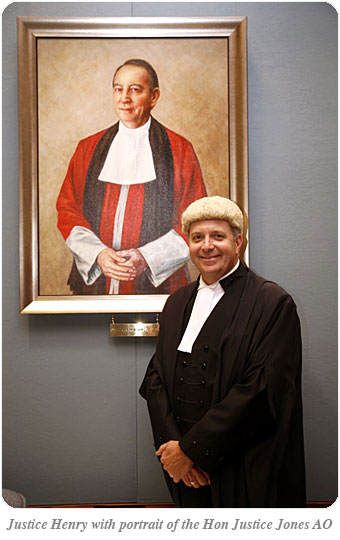 Educated in regional Queensland and graduating in Arts and Law from the University of Queensland, His Honour was admitted to the Bar in 1986, developing a specialist criminal practice in the Crown service, in which he continued until the year 2000, when he entered into private practice in Cairns. His practice then diversified to cover most areas of the law. My information and belief is that he is highly regarded by his professional colleagues for his legal learning and experience, balance, and capacity for hard work. In that last respect, I note this is a particularly busy Supreme Court centre.
Educated in regional Queensland and graduating in Arts and Law from the University of Queensland, His Honour was admitted to the Bar in 1986, developing a specialist criminal practice in the Crown service, in which he continued until the year 2000, when he entered into private practice in Cairns. His practice then diversified to cover most areas of the law. My information and belief is that he is highly regarded by his professional colleagues for his legal learning and experience, balance, and capacity for hard work. In that last respect, I note this is a particularly busy Supreme Court centre.
During those years in Far North Queensland, Justice Henry has commendably been involved in community life, for example chairing the Cairns State High School Council since the year 2008.
I expect that 11 years “on the ground” qualifies His Honour as a Far North Queenslander. He now embraces a unique opportunity to leave his beneficial mark on the region — potentially for as long as 21 years.
I have spoken on other occasions about the central importance of Supreme Court appointments to regional centres, where the Judge operates without the direct collegial support characteristic of the court in Brisbane, and where the Judge daily presents as the sole face in the region of this significant institution. That is of course not to suggest that a regional judge is divorced in some way from the rest of the court: far from it, the court exhibits strong cohesion State-wide. But those features do 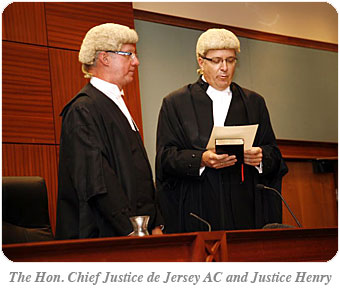 nevertheless combine to render regional appointments especially significant. Throughout my judicial career, the regions and the State have been very well served by the regional Judges, who have additionally assumed with great impact high leadership roles in relation to the regional professions, including the judiciary, and the regional communities. I am confident Justice Henry will do likewise.
nevertheless combine to render regional appointments especially significant. Throughout my judicial career, the regions and the State have been very well served by the regional Judges, who have additionally assumed with great impact high leadership roles in relation to the regional professions, including the judiciary, and the regional communities. I am confident Justice Henry will do likewise.
That extends to collegial interaction with the Judges of the District Court and the Magistracy, whose dedication is greatly valued. I have always been especially gratified by the support for these occasions of the Chief Judge and Chief Magistrate, signifying a State-wide court cohesion which is not only personally pleasant, but has, as well, produced some publicly worthwhile outcomes.
That this ceremony takes place in Cairns rather than Brisbane signifies the court’s acknowledgement of the regional significance of which I have spoken this morning. That all Judges are present by one means or other, signifies the Far Northern Judge’s membership within a State-wide court of 26 members, collegially bound to the optimal delivery of justice according to law throughout the State.
We all warmly welcome Justice Henry to the court, and we warmly welcome Mrs Kate Henry to the court community.
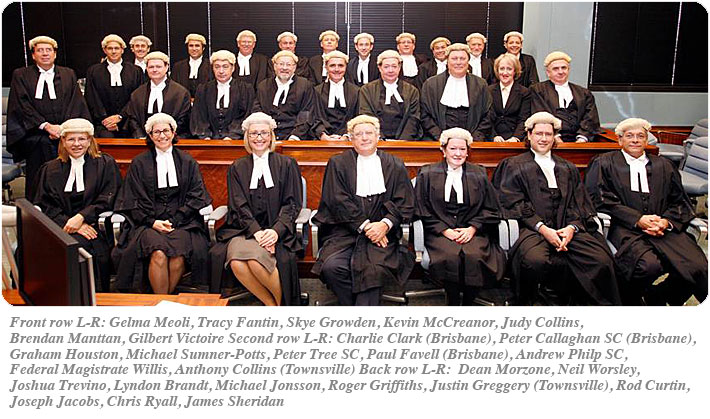
What does this mean to practitioners?
The nationalisation of the business names registration process introduces a significant streamlining in the ability to identify the operator of a business name registration and adds strength to the case that the use of a deceptively similar mark to a registered trade mark is not an innocent one.
Introduction
There is a proposal through the Business Names Registration Bill 2011 to create a national register of business names, which shall be administered by the Australian Securities and Investments Commission (ASIC). The Council of Australian Governments (COAG) agreed in July 2008 to the development of a single national system for registering and regulating business names.
The primary purpose of the national registration scheme is to ensure that any business that does not operate under its own entity name, registers its name and details on a national register to enable those who engage or propose to engage with that particular business to determine the identity of the entity behind the business name and its contact details.1
The focus of the business names legislation continues to be a method by which a person is able to identify the party operating the business. The proposal, however, introduces a vehicle by which an old and continuing problem for trade mark owners might begin to be addressed.
The problem
The relationship between the trade marks register, kept by the Registrar of Trade Marks, and the business name and company registers administered by the states and ASIC respectively, has been the source of some confusion to traders and the public who deal with them. The confusion arises because it has been possible to register a business name or incorporate a company with a name which is deceptively similar to a registered trade mark, the reason for this being that neither the states nor ASIC cross reference the names applied for with the trade mark register.
The confusion lies predominantly in two areas:
(a) a perception that upon registration of the corporate or business name, the registrant somehow obtains a proprietary interest in the name — a perception that they own it;
(b) that by reason of the business name registration process, there must have been some cross referencing with other government departments so that the registration has not offended the rights of trade mark owners.2
There are of course applicants for registration of a business name or incorporation of a company who do so strategically, well aware of the rights of trade mark owners and their authorised users.
Education of users
IP Australia have for several years undertaken a strategy of seeking to educate the public and make them aware of the existence of the trade mark register. For example warnings such as:
“Caution: When you register your business name, be careful that it does not infringe on someone else’s trade mark. It is always wise to search the trade mark databases first.”3
One difficulty is that it is not easy to conduct an IP Australia trade mark search (ATMOSS ) as a member of the public. Search terms and references to various classes of goods and services add to the complexity of such a search. This is particularly the case for business owners who have English as their second language. Statistics in 2006 indicated that 29 percent of small to medium business operators were born overseas.4
A step in the right direction
An advantage of the proposal is that the process of business registration is more streamlined and conducted at one national level — as is the trade mark register.
The awareness, however, of the trade marks applied for or registered will not be left to education of the public alone. With the launch of the national register, which is expected in July 2012, there will be a simultaneous launch of a product developed through the Dept of Innovation, Industry, Science and Research and IP Australia, over the last 5 years known as TM Check.
Essentially TM Check is a simplified search tool which requires the input of two pieces of information:
(a) the business name which is sought;
(b) the goods or services describing the nature of the business.
In this regard, the list of goods and services has been highly simplified. The conduct of the TM Check could not on any reasonable construction be considered onerous. As a result, applications for business name registration may be streamed via the trade mark register on their course to business name registration.
It is proposed that upon filling out the application for registration of the business name, there will be two questions where the box must be ticked as an acknowledgement that they have been read. The first relates to an acknowledgment that the applicant is aware that a business name does not entitle the applicant to ownership of the name. The second acknowledges that the name being sought may inadvertently be offending the rights of a trade mark owner and the business name applicant is invited to conduct a simple check of the trade mark register to ascertain if the name so offends. The applicant will then be invited to use the link to conduct the TM Check.
It has been my recommendation to the Department that the TM Check should be made compulsory rather than an option.5 By making it compulsory, I considered some of the advantages would be:
- that an innocent party might be made aware at an early stage that the name they have selected could be considered substantially identical with or deceptively similar to a registered trade mark and thereby avoid the costs of setting up with a name they are likely to have to change;
- there are several trade mark advantages in being able to attribute notice of a registered trade mark to the business name applicant.
There are two aspects of trade mark law, to which evidence of notice of the registered mark will have relevance.
Firstly, a claim by a trader under s 43 of the Trade Marks Act 1995 that the use of the mark the subject of the trader’s trade mark application is entitled to the benefit of the honest concurrent user provision contained in s 44(3). Secondly, notice of the registered trade mark may be relevant in considering whether the court may exercise its discretion to award additional damages for trade mark infringement. The power to grant additional damages for trade mark infringement is provided for in the Intellectual Property Laws Amendment (Raising the Bar) Bill 2011.6
Dimitrios Eliades
Barrister
Footnotes
- Business Names Registration Bill 2011 Explanatory Memorandum
- The nationalisation of the business name registers will add to the confusion as it will be perceived that as ASIC and the Registrar of Trade Marks are instruments of the Federal Government, there must be
- “dialogue” between them to identify offensive names.
- http://www.ipaustralia.gov.au/trademarks/what_names.shtml
- http://www.innovation.gov.au/SmallBusiness/KeyFacts/Documents/SmallBusinessDataCard.pdf
- Submission at www.deliades.com.au under ‘Trade Marks’.
- The Raising the Bar Bill 2011 at Part 3 Item 29 as an addition to s 126 of the Trade Marks Act.
Your Honours, Colleagues and Guests:
Welcome to the “Queensland Bar Dinner”.
I coin it thus because, in years past, it was known often as the “High Court Dinner”.
In past years with the coincidence of the High Court sitting and mid-year school vacation, and this year the absence of any High Court sitting in Brisbane, the fresh label is apt.
The Bar Association hopes, however, that the High Court once through its budgetary difficulties, will see its way clear to renew the annual visits.
Guests:
Many of the heads of jurisdiction, or court or tribunal divisions have honoured us with their presence.
Justice Susan Kiefel and Chief Justice Patrick Keane have asked me to extend their regrets at not being able to join us this evening.
The acknowledged leader of the legal profession in Queensland, Chief Justice Paul de Jersey, is with us.
Chief Justice, it gives me pleasure to announce this evening that the reading and function room at the new Bar premises, which opened last week, will be named the “Paul de Jersey Room” in your honour as our leader now for over 13 years. You are soon to officially open the premises for us.
Court of Appeal President Justice Margaret McMurdo is also with us. Her Honour is a strong supporter of Association endeavours.
Through you, Justice McMurdo, the Association congratulates the court on the celebration this year of 20 years since establishment of the appeal division. I encourage all present to attend the court’s celebratory Keith Mason lecture on 24 October which we will again circularize.
District Court Chief Judge Patsy Wolfe is also with us. We congratulate you, Judge, for your 12 years service in stewardship of your important trial court, and for your unfailing support of the Association.
Chief Magistrate Judge Brendan Butler SC is here too. Judge, at your recent conference at which I spoke many a magistrate told me of the steady hand you have brought to bear in your large decentralised court.
AAT Deputy President Philip Hack SC is with us tonight. Mr Hack, along with Justice Glenn Martin, at the forthcoming AGM, have been nominated this year for life membership for their long and dedicated service to our Association.
I welcome too the other judges and magistrates who have joined us.
Regulator:
The Legal Services Commissioner John Briton is also with us. John, without fail, attends our annual conference and this dinner and meets with Bar Council members regularly on regulatory issues.
The Association has an excellent relationship with John and his staff and we welcome his recent reappointment.
Parliamentary Colleagues:
The Attorney General, the Honourable Paul Lucas, cannot be with us. He is on holidays overseas with his family.
Despite the Association’s recent public differences with the Attorney over the introduction of substantial court fees, the Attorney and I continue to speak regularly on justice issues and we enjoy an excellent relationship.
The Shadow Attorney General, and solicitor, Jarrod [P: BLAY] Bleijie, is with us this evening.
Jarrod, thank you for accepting our invitation and for your regular well-informed arm’s length dealings with the Association.
Our Solicitor Colleagues:
Queensland Law Society President Bruce Doyle cannot be with us as he is in Korea.
The Society’s immediate past President, and great friend of the Bar, Peter Eardley, is here. We welcome you Peter.
We also welcome Society CEO Noela L’Estrange. Noela is a font of knowledge on all matters pertaining to our profession and a great companion.
Interstate Colleagues:
One of the great pleasures of my role is to mix regularly, through the boards of the Australian Bar Association and the Law Council, with our interstate Bar Colleagues.
My predecessor Michael Stewart SC, as you know, is the ABA President, and he is here tonight.
The industrious and well travelled president of the Law Council, Alex Ward, a South Australian barrister, honours us with his attendance this evening. Welcome Alex.
Present also tonight as our honoured guests are the Chairman of the Bar Council of Victoria Mark Moshinsky SC, President of the South Australian Bar Association Mark Livesey QC, President of the ACT Bar Association Philip Walker, and the longstanding CEO of the New South Wales Bar Association Philip Selth OAM.
Please introduce yourself to these people if you don’t already know them. In many ways they contribute greatly to the wellbeing and efficient conduct of the profession of the Bar across this country.
Purpose of Tonight:
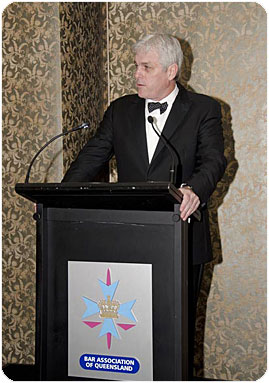 The purpose of tonight, of course, is for us to enjoy the company of our bar, judicial and other legal colleagues away from the adversarial arena.
The purpose of tonight, of course, is for us to enjoy the company of our bar, judicial and other legal colleagues away from the adversarial arena.
Collegiality is a cornerstone of the bar. It nurtures courtesy, industry and appropriate ethical conduct.
We are a strong bar in quality and quantity.
Almost every barrister in Queensland with a practising certificate is a member of the Bar Association, despite membership being voluntary and attracting subscription.
The Association has 900 private bar members, 163 government employed bar members and 213 associate members consisting of judges, retired judges and academics.
The current Bar Council enjoys a complement of well credentialed and industrious men and women. Presidential succession is assured.
The Association recently moved into commodious new premises at reasonable cost, fitting them out with the latest electronic means of servicing our information hungry decentralised and busy membership.
Proudly, we were the first bar or law association to pioneer and introduce for members, this year, a low cost and generously conditioned life and TPD scheme.
We conduct the largest annual bar conference in Australia and a high quality CPD program.
We have a reputation for assisting sensibly with submissions but if necessary taking to task the government of the day [and, Jarrod, that will include any future government] who we consider, objectively, to be acting contrary to the public interest.
We have much to be proud of.
I relinquish my role as President on the 21st November. I must confess that will involve some blessed relief on my part but I have enjoyed the ride.
I will return later this evening to briefly introduce our speakers.
See you in a while.
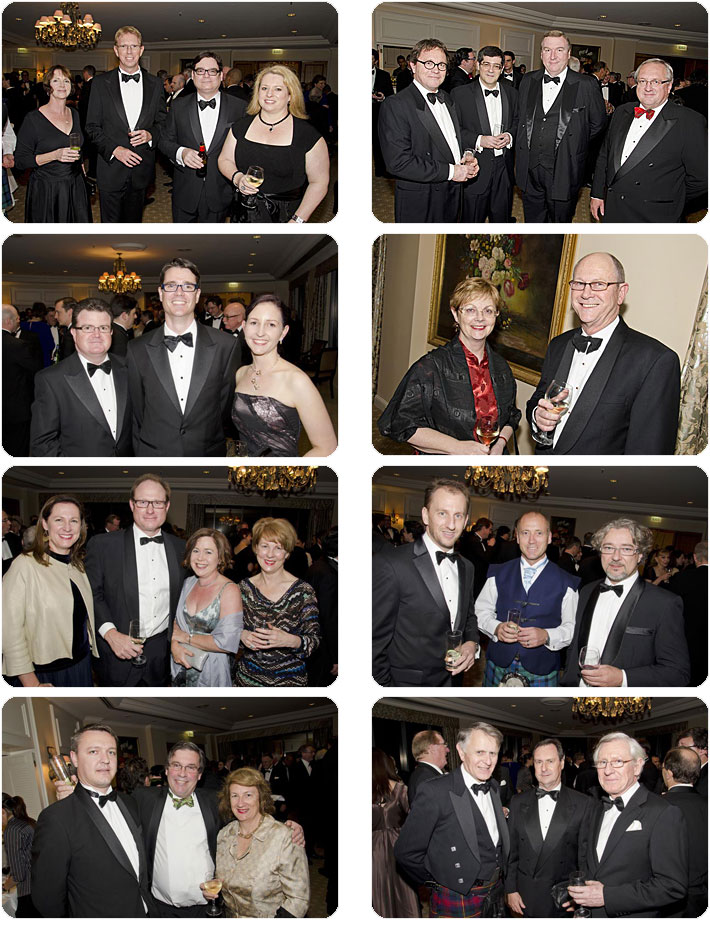 Christopher Hughes:
Christopher Hughes:
The toast to the judiciary will be delivered this evening by Christopher Laurence Hughes SC.
Following a distinguished academic career in Australia and the United Kingdom, and with his creditors and the fathers of various respectable women at his tail, Christopher was admitted in 1980. I lent him the admission fee. I think he repaid me.
Christopher took silk 10 years ago.
He is one of Queensland’s, and probably one of Australia’s leading planning and environment counsel.
He is a practical joker, and like most so described he sometimes goes over the top.
I can recall years ago my wife dropped me off at the lights near chambers and as I raced off I saw Chris with his head in the window looking at our four then smiling and attentive little daughters in the back of the vehicle.
Rosemary told me later that as she was about to pull away on the then green light he said to the girls: “One day I will tell you the name of your real father”.
I still haven’t sent him the bill for all psychological counselling the children required.
I ask you to welcome Christopher Hughes SC.
…
Justice Chesterman:
Justice Richard Noel Chesterman AO RFD was admitted in 1968 and appointed Queen’s Counsel in 1983.
In 1998 he was sworn a judge of the Trial Division of the Supreme Court in 1998 and in 2008 was elevated to the Appellate Division.
In the Queen’s Birthday honours list this year his Honour was awarded the Order of Australia, the award particulars reading:
For distinguished service to the judiciary as a judge of the Supreme Court of Queensland and to the community, particularly through contributions to the Cancer Council at national and state levels.
He is chairman of the State Cancer Council.
Of his Honour’s many life experiences, one which always resonated with me was that of him being a young lawyer travelling from Australia on an Italian cruise liner bound for passage through the Panama Canal. The engines broke down and the liner was adrift for five days awaiting tow. Social order among passengers and crew also then broke down leading, among other things, to the suicide of the ship’s captain.
These days the rest of us can undertake a generally safe aeroplane journey to travel overseas.
I invite Justice Chesterman to respond, for the judiciary, to Christopher’s toast.
Conclusion:
That concludes the formal part of this evening.
Two people I should mention before rising, and it will embarrass them, are Dan O’Connor and Peter Roney SC.
Dan, our go-to man of the Association, is celebrating (and I say euphorically) 17 years as our CEO.
Thanks Dan for your industry, company and perseverance. Long may you reign.
Peter Roney, despite peak fitness, suffered an unusual medical misadventure earlier this year. The high-jump was close.
He is back in the saddle and is here tonight. Good to see you Peter.
Colleagues, please enjoy yourselves and stay at least until asked to leave.
Thank you for attending. 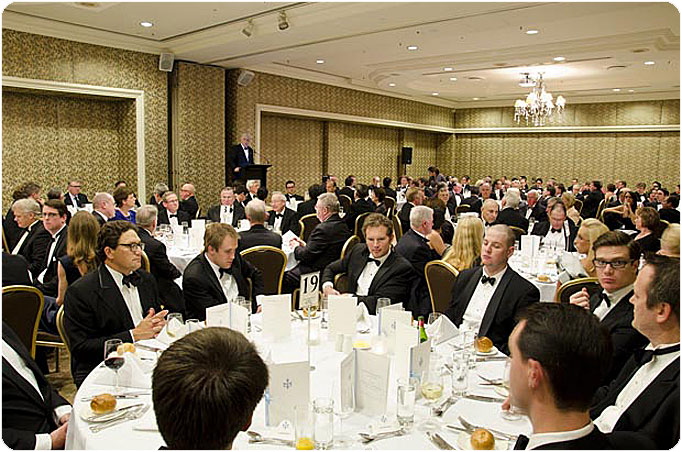
Mr Hughes, Mr Douglas President of the Bar Association, your Honours, ladies and gentlemen. Before responding to the toast proposed so eloquently by Mr Hughes may I express my thanks to the President and the Bar Council for their invitation to address this important occasion in the life of the Bar, and the bench. I am conscious of the honour you confer on me.
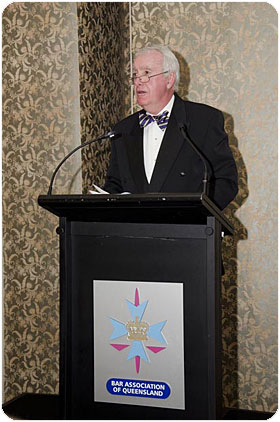 The judges are, of course, indebted to Mr Hughes for his good natured toast and for the confidence, which I think he has expressed, in our capacity to perform our arduous duty. We judges are human. Part of our human frailty is to enjoy flattery and Mr Hughes is practised in those arts. He may indeed have learned something from Justice White’s address last year.
The judges are, of course, indebted to Mr Hughes for his good natured toast and for the confidence, which I think he has expressed, in our capacity to perform our arduous duty. We judges are human. Part of our human frailty is to enjoy flattery and Mr Hughes is practised in those arts. He may indeed have learned something from Justice White’s address last year.
I enjoyed listening to Mr Hughes, but as I listened I began to wonder why he bothered. I mean by that I wondered why the Bar continues with this venerable tradition of inviting judges to its convocation of collegiality, when judges as a class are becoming irrelevant to the manner in which most of you now practice your profession.
I do not wish to sound ungracious, nor to doubt the sincerity of the invitation you extend to Her Majesty’s judges. We all appreciate being among you and experiencing the conviviality of the Bar. But why do you ask us?
We are all familiar with the concept of the vanishing trial. An inevitable consequence of that phenomenon is the vanishing judge. We are disappearing behind notices of claim, statutory exhortations to settle early and often, pre-trial procedures designed to prevent actions coming on for trial, single expert reports and practice directions now so numerous and complex that there will shortly be a need for a practice direction about how to comply with practice directions. The manifest purpose of these measures is to ensure that the investigation of fact and law which used to occur at a trial now occurs before a claim can be issued so that the sense of catharsis and satisfaction counsel used to feel at the conclusion of a successful cross-examination, or a triumphant address which has brought a sceptical judge to the point of persuasion, now comes with the filing of the claim.
So I repeat the question I posed earlier: why do you persist with the toast to the judiciary?
I have not mentioned the phenomenon of mediation which is perhaps the single most important cause in the decline of the trial. I do not criticise mediation or mediators. How could I? My very great friend Ian Hanger is among us. I simply make the point that as mediation flourishes litigation withers. But mediation may provide an answer to my question. Mediation needs judges. If judges entirely vanished you would have to invent us. We are needed, as the Bastille was needed, as a symbolic source of dread against which to revolt. Without the threat that judges exist, and might actually try a case, mediations would fail.
I believe I know how they work. The mediator’s opening gambit is to ask each of the parties how much they have spent to date. The figures are given, added up, and then rounded up to the next highest $100,000, or perhaps the one after that. A look of polite surprise comes to the mediator’s face as he says “judges are expensive, aren’t they?”
If that does not work you say worse things about us. You put us into categories, and say to the parties that if the case is not settled it will be tried by a judge (a) from whom they will never get a judgment; or (b) from whom they will get a judgment, but the wrong one; or (c), from a judge who will give the right judgment but at such high personal cost that the health of counsel and client may not recover for a year.
If any of my judicial colleagues present is uncertain of the category into which you have been put, I suggest you turn to the barrister nearest to you, and ask.
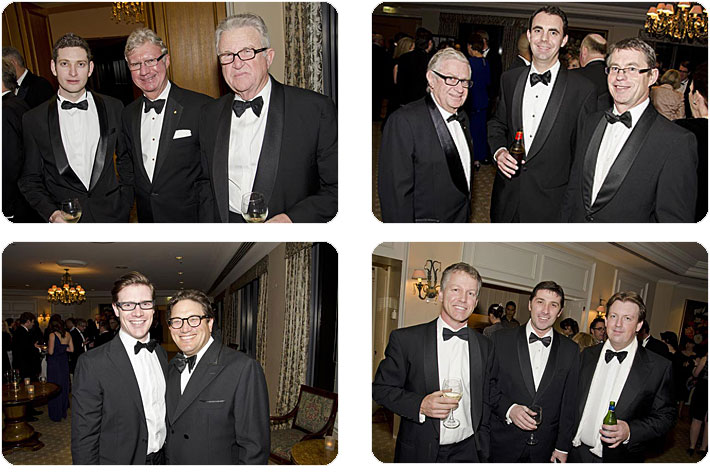 There may be another reason why you drink our health. It may be that you are profoundly grateful that we are not worse than we are. Bye and large the judges before whom you appear are competent and conscientious. There is much to be said for that accomplishment. It is not hard to find in times and places not far removed examples of very bad judges.
There may be another reason why you drink our health. It may be that you are profoundly grateful that we are not worse than we are. Bye and large the judges before whom you appear are competent and conscientious. There is much to be said for that accomplishment. It is not hard to find in times and places not far removed examples of very bad judges.
When the commercial list was re-established seven or eight years ago John Muir and I were called upon to address professional gatherings to explain the reasons for its establishment and how it would function. In my set address I used to refer to the establishment of the Commercial Court in England in 1895 which came about as a consequence of a series of judgments in commercial cases in which judges had performed very badly. The last straw was a judgment by Mr Justice Lawrance which overlooked half the issues in the case and misunderstood the other half. Lord Justice MacKinnon once said of him:
“He was a stupid man, a very ill equipped lawyer, and a bad judge. He was not the worst judge I have ever appeared before: that distinction I would assign to Mr Justice Ridley; Ridley had much better brains than Lawrance, but he had a perverse instinct for unfairness that Lawrance could never approach.”
But bad judges are not to be found only in the English past. Judge Gielor of California was removed from office less than 40 years ago. He was described as “a man of a rumbustuous personality, sometimes given to sexual harassment.” Once in chambers the judge thrust a battery operated dildo into a public defender’s buttocks. The result was so satisfactory from the judge’s point of view that he took the device to court and used it to truncate cross-examination.
The same public defender was about to ask a question when judge Gielor said to his clerk:
“Get the machine out”. The clerk asked “the battery?” The judge replied “the battery”.
There were no further questions.
Encouraged by this success the judge tried again. A subsequent cross-examination was interrupted in similar circumstances. This was the exchange:
Judge to clerk — “Did you get those batteries?”
Clerk- “I’m charging it up. I’ve got a bigger one. 15 volts.”
Judge to counsel — “David, we’ve got a 15 volter in there now.”
Clerk — “With a longer handle.”
Judge — “Hurry, David. We’ve got a 15 volt battery for you.”
Counsel — “I have no further questions.”
You may well think that it is worth toasting a judiciary that does not include a Lawrence, a Ridley or a Gielor.
Another reason may be that all judges today are polite. That is an improvement on the past but judicial politeness can be overrated. It can become a form of cruelty. Let me give you an example. Mr Justice Graham was a judge of the early 19th Century. He was said, perhaps uniquely for his time, to be exquisitely courteous in dealing with prisoners. On one occasion at the Old Bailey he had to pronounce sentences of death on 16 hapless petty thieves. He overlooked one and only sentenced 15. The jailer pointed out the omission and Graham called the man who had been spared back to the dock. He addressed him apologetically:
“I find I have accidentally omitted your name in my list of prisoners doomed to execution. It was quite accidental, I assure you. I ask your pardon for my mistake. I am very sorry and all I can add is that you will be hanged with the rest.”
I wish to end on a serious note. There is no need to search, earnestly or facetiously, for a reason why the Bar should toast the judiciary, and why we should respond with our own expressions of affection and respect for the bar. We are all engaged in a serious and important endeavour, the seriousness and importance of which is often overlooked in our preoccupations with daily routine. We all seek the betterment of society by seeing that justice is done to all who come to the law for its protection, or for vindication. Whatever the dispute, whatever the court, a resolution according to law by peaceful and civilised means is a social good the value of which should not be underestimated. There was a time in the early history of this country when the courts were the only organ of good government. There are still instances when courts must stand against the tides of public and even Parliamentary rage. They could not and cannot perform that role, or their ordinary one, without the independence and integrity of the bar. Our functions are complimentary and interdependent. I thank Mr Hughes who on your behalf has given your commitment to this endeavour, and on behalf of the judges, I reciprocate.
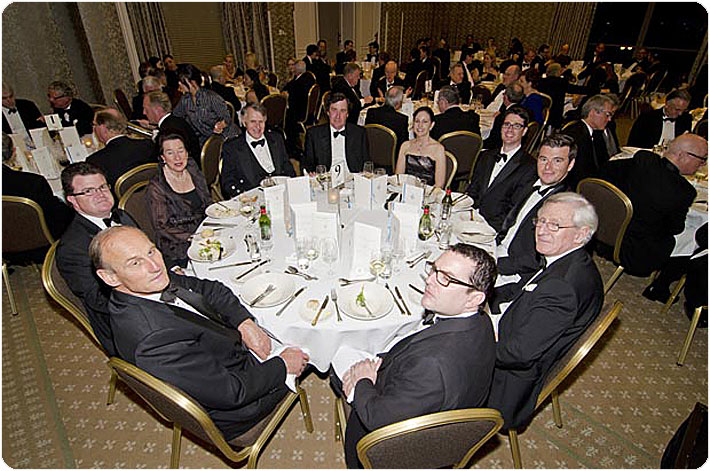
The grainy black and white photographs showed a mass of men, their faces blurred for anonymity, crowded into a room reminiscent of a 1950’s asylum. Evoking strong emotions, the photographs would not have been out of place in a tabloid exposé. Instead, they were attached to a recent judgment of the US Supreme Court in Brown v Plata,1 in which the majority held that California’s prisons are so overcrowded that they are a violation of the Constitution’s ban on cruel and unusual punishment, and that the State must release or relocate some 32,000 inmates over the next 2 years. In the majority judgment, Justice Kennedy referred to 2 appendices. Appendix B contained 2 photographs of hundreds of inmates crowded into open gymnasium-style rooms. Appendix C, an image of a telephone booth sized cage used to hold people on suicide watch. The inclusion of the photographs attracted comment2 and questions about the inclusion in the court’s reasons of such visual aids.
Once upon a time, reasons for judgment included only words. More recently, it is not unheard to find photographs, maps, extracts of submissions, media articles (and in the US, video footage) attached to a court’s reasons.
The failure of a trial judge or tribunal member to give adequate reasons for judgment can amount to an error of law and is a commonly raised ground in civil appeals confined to error of law (eg. appeals from the Planning & Environment Court, the Queensland Industrial Relations Commission, appeals without leave from Queensland Civil and Administrative Tribunal). The inclusion of visual aids in a judgment raises an interesting question about how such material might be construed as part of the reasons and whether the inclusion of it could lend itself to a ground of appeal.
A search (which does not profess to be exhaustive) for the purposes of this article did not reveal any Australian decisions in which this issue had arisen. However one could imagine that the inclusion of a photograph or video footage might raise questions about the purpose of the image and what it adds to the text, its potential importance and whether the reasons articulate adequately its significance and weight. If the decision maker referred to an image, for example, to illustrate a conclusion or on the basis that the image “spoke for itself”, there is a risk that another person viewing the image might not draw the same conclusion or impression. An image may do no more than add an emotional aspect to the reasons. One can imagine objections to the inclusion of visual aids on the basis of authenticity, lack of context, and manipulation (even if the picture itself is authentic).
The case referred to above provides a convenient, if tenuous, link to considering the relevant principles on the adequacy of reasons for the purposes of a ground of appeal, and when inadequate reasons will amount to an error of law.
In Drew v Makita (Australia) P/L [2009] 2 Qd R 219 at 2373 the Court of Appeal (Muir JA, with whom Holmes JA and Daubney J agreed) summarised the relevant principles:
1. A court from which an appeal lies must state adequate reasons for its decision: Sun Alliance Insurance Ltd v Massoud [1989] VicRp 2; [1989] VR 8 at 18, 19; Pettitt v Dunkley [1971] 1 NSWLR 376 at 388; Soulemezis v Dudley (Holdings) Pty Ltd (1987) 10 NSWLR 247 at 270, 279, 280 per McHugh JA.
2. Failure to give sufficient reasons constitutes an error of law: Soulemezis v Dudley (Holdings) Pty Ltd (Supra); Res 1 v Medical Board of Queensland [2008] QCA 152 at 14; Beale v Government Insurance Office of NSW (1997) 48 NSWLR 430 at 431; Fitzgibbon v Waterway Authority [2003] NSWCA 294.
3. The rationale for the requirement that courts give reasons for their decisions provides some guidance as to the extent of the reasons required. The requirement has been explained, variously, as necessary:
(a) to avoid leaving the losing party with “a justifiable sense of grievance“: Beale v Government Insurance Office of NSW (Supra) at 431.
(b) through not knowing or understanding why that party lost: Beale v Government Insurance Office of NSW (Supra) at 442;
(c) to facilitate or not frustrate a right of appeal: Soulemezis v Dudley (Holdings) Pty Ltd (Supra) at 259, 271; Public Service Board of New South Wales v Osmond [1986] HCA 7; (1986) 159 CLR 656 at 666 — 667 per Gibbs CJ; Waterways Authority v Fitzgibbon [2005] HCA 57; (2005) 79 ALJR 1816 at 129;
(d) as an attribute or incident of the judicial process: Soulemezis v Dudley (Holdings) Pty Ltd (1987) 10 NSWLR 247 at 257, 269, 273, 279;4
(e) to afford natural justice or procedural fairness: Soulemezis v Dudley (Holdings) Pty Ltd (Supra) at 279; Flannery v Halifax Estate Agencies [1999] EWCA Civ 811; [2000] 1 WLR 377 at 381 — 392; Waterways Authority (Supra) at [129]; Cypressvale Pty Ltd v Retail Shop Leases Tribunal [1995] QCA 187; [1996] 2 Qd R 462 at 475, 476;
(f) to provide “the foundation for the acceptability of the decision by the parties and the public” and to further “judicial accountability“: Soulemezis v Dudley (Holdings) Pty Ltd (Supra) at 279.
4. The extent to which a trial judge must expose his or her reasoning for the conclusions reached will depend on the nature of the issues for determination and “the function to be served by the giving of reasons“: Housing Commission of New South Wales v Tatmar Pastoral Co Pty Ltd [1983] 3 NSWLR 378 at 386.
 5. For that reason, what is required has been expressed in a variety of ways:
5. For that reason, what is required has been expressed in a variety of ways:
(a) in Soulemezis v Dudley Mahoney JA said:
“… And, in my opinion, it will ordinarily be sufficient if — to adapt the formula used in a different part of the law … by his reasons the judge apprises the parties of the broad outline and constituent facts of the reasoning on which he has acted.”
(b) McHugh JA’s view in the same case was that reasons sufficient to meet the above requirements do not need to be lengthy or elaborate but “… it is necessary that the essential ground or grounds upon which the decision rests should be articulated.”;
(c) In Strbak v Newton (Unreported, New South Wales Court of Appeal, Gleeson CJ, Samuels and Priestley JJA, 18 July 1989) Samuels JA said:
“…What is necessary, it seems to me, is a basic explanation of the fundamental reasons which led the judge to his conclusion. There is no requirement, however, that the reasons must incorporate an extended intellectual dissertation upon the claim of reasoning which authorises the judgment which is given.”
(d) Woodward J in Ansett Transport Industries (Operations) Pty Ltd v Wraith, [1983] FCA 179; (1983) 48 ALR 500 at 507 said that the decision maker:
“…should set out his understanding of the relevant law, any findings of fact on which his conclusions depend (especially if those facts have been in dispute), and the reasoning processes which led him to those conclusions .”
(e) Meagher JA in Beale v Government Insurance Office of NSW (Supra) stated these propositions at 443 — 444:
“…there are three fundamental elements of a statement of reasons, which it is useful to consider. First, a judge should refer to relevant evidence. There is no need to refer to the relevant evidence in detail, especially in circumstances where it is clear that the evidence has been considered. However, where certain evidence is important or critical to the proper determination of the matter and it is not referred to by the trial judge, an appellate court may infer that the trial judge overlooked the evidence or failed to give consideration to it: North Sydney Council v Ligon 302 Pty Ltd (1995) 87 LGERA 435. Where conflicting evidence of a significant nature is given, the existence of both sets of evidence should be referred to.
 Secondly, a judge should set out any material findings of fact and any conclusions or ultimate findings of fact reached. The obvious extension of the principle in North Sydney Council is that, where findings of fact are not referred to, an appellate court may infer that the trial judge considered that finding to be immaterial. Where one set of evidence is accepted over a conflicting set of significant evidence, the trial judge should set out his findings as to how he comes to accept the one over the other. But that is not to say that a judge must make explicit findings on each disputed piece of evidence, especially if the inference as to what is found is appropriately clear: Selvanayagam v University of the West Indies [1983] 1 WLR 585; [1983] 1 All ER 824. Further, it may not be necessary to make findings on every argument or destroy every submission, particularly where the arguments advanced are numerous and of varying significance: Rajski v Bainton (Court of Appeal, 6 September 1991, unreported).
Secondly, a judge should set out any material findings of fact and any conclusions or ultimate findings of fact reached. The obvious extension of the principle in North Sydney Council is that, where findings of fact are not referred to, an appellate court may infer that the trial judge considered that finding to be immaterial. Where one set of evidence is accepted over a conflicting set of significant evidence, the trial judge should set out his findings as to how he comes to accept the one over the other. But that is not to say that a judge must make explicit findings on each disputed piece of evidence, especially if the inference as to what is found is appropriately clear: Selvanayagam v University of the West Indies [1983] 1 WLR 585; [1983] 1 All ER 824. Further, it may not be necessary to make findings on every argument or destroy every submission, particularly where the arguments advanced are numerous and of varying significance: Rajski v Bainton (Court of Appeal, 6 September 1991, unreported).
Thirdly, a judge should provide reasons for making the relevant findings of fact (and conclusions) and reasons in applying the law to the facts found. Those reasons or the process of reasoning should be understandable and preferably logical as well.”
6. The three “fundamental elements” should not be applied rigidly, but they provide useful guidance for a determination of the sufficiency of reasons in the general run of cases.
In resolving conflicts of expert evidence, a trial judge may need to be more explicit in the reasons and include a coherent reasoned explanation for why one expert’s evidence is preferred over another: Flannery v Halifax Estate Agencies Ltd [1999] EWCA Civ 811; [2000] 1 WLR 377 at 381 — 382 referred to with approval in the reasons of Ipp JA in Wiki v Atlantis Relocations (NSW) Pty Ltd [2004] NSWCA 174; (2004) 60 NSWLR 127 at 137.
However, the Queensland Court of Appeal in Tendiris Pty Ltd and Anor v Moreton Bay Regional Council and Ors5 recently cautioned in relation to conflicting expert evidence:
“… it is not the duty of a judge to decide every matter raised in argument; the judge ‘may decide a case in a way which does not require the determination of a particular submission: in such a case he may put it aside or, as Lord Scarman said, merely salute it in passing … Where it is submitted that evidence is relevant, or where it is not clear that it is irrelevant, it may be necessary in a particular case for the reasons to explain why the judge has concluded that it is irrelevant, ….” [footnotes omitted]
Contrast this with statements in Cypressvale P/L & Anor v Retail Shop Lease Tribunal [1996] 2 Qd R 462 [6] to the effect that where a Judge has to decide between conflicting witnesses the choice is often a matter of judgment, not of detailed reasoning.7 It is “plainly unnecessary” for a judge to refer to all the evidence led in the proceedings, or to indicate which of it is accepted or rejected, although failure to explain the basis of a crucial finding of fact involves a breach of the principle. The obligation to do so does not exist in respect of every matter, of fact or law, which was or might have been raised in the proceedings. Nor is it necessary for a judge who is exercising a discretionary judgment to detail each factor which he has found to be relevant or irrelevant, or to itemise which of the factual matters to which he has had regard.8
Putative errors of law should be presented by an appellant so as to be recognisable as such by the appellate court without the need for that court to descend into the evidence to be reviewed on the proposed appeal in order to determine whether leave should be granted.9
In Camden v McKenzie [2008] 1 Qd R 39 Keane JA (with whom McMurdo and Douglas JJ agreed) said at 30-31:
“The appellants contend … that adequate reasons for judgment will refer to the evidence which was important to the determination of the matter, and will set out material findings of fact, given the judge’s reasons for his … findings of fact, and stating the basis on which the judge has come to prefer one body of evidence over a competing body of evidence.
As a general rule, observance of these requirements is necessary to demonstrate that litigation has been determined fairly and rationally. Adherence to these requirements ensures that rights of appeal are not rendered meaningless, and that a party affected by a decision adverse to his or her interests is not left with the justified sense of grievance that the case has not been properly considered. In short, these standards promote the conscientious public discharge of the responsibilities of a judge to litigants, as well as to the community, which has a vital interest in the integrity of the judicial process.” [footnotes omitted]
More recently, the principles in Beale and Soulemezis, relied upon in Drew v Makita, were affirmed by the NSW Court of Appeal in Alchin v Daley [2009] NSWCA 418, in which it was said that it is essential to expose the reasoning on a point critical to the contest between the parties, and where credit issues are involved, it is necessary to explain why one witness is preferred to another. Consequently, bald findings on credit, where substantial factual issues have to be addressed, may not comply with the common law duty to give reasons.
In conclusion, it is clear that the extent of the duty to give reasons will vary depending on the function that is served by the giving of reasons and the nature of the evidence being considered .
Tracy Fantin
Equity Chambers, Cairns
Footnotes
- Brown, Governor of California v Plata 131 S. Ct. 1910 (2011), (23 May 2011) at http://www.supremecourt.gov/opinions/10pdf/09-1233.pdf . In a 5:4 decision, Kennedy J delivered the opinion of the court, in which Ginsburg , Breyer , Sotomayor , And Kagan JJ joined. Scalia J filed a dissenting opinion in which Thomas J joined. Alito J filed a dissenting opinion in which Roberts CJ joined.
- “Show, Don’t Tell – Do photographs of California’s overcrowded prisons belong in a Supreme Court decision about those prisons ?” By Dahlia Lithwick May 23, 2011 in Slate. See http://www.slate.com/articles/news_and_politics/jurisprudence/2011/05/show_dont_tell.html
- At [57]-[64]. Recently cited in In Vitro Technologies Pty Ltd v Taylor [2011] QCA 44 (15 March 2011); Littlejohn v Julia Creek Town and Country Club Inc [2010] QCA 361; Tendiris Pty Ltd & Anor v Moreton Bay Regional Council & Ors [2010] QCA 349; [2011] QPELR 289.
- Recently emphasised by the High Court in Wainohu v New South Wales [2011] HCA 24 (23 June 2011) at [55] (fn 134 citing Cypressvale Pty Ltd v Retail Shop Lease Tribunal [1995] QCA 187; [1996] Qd R 2 462 at 483; Crystal Dawn Pty Ltd v Redruth Pty Ltd [1998] QCA 373) and at [56] — [59]).
- [2010] QCA 349 per Fraser JA at [24]
- Cypressvale P/L & Anor v Retail Shop Lease Tribunal [1996] 2 Qd R 462 per Fitzgerald P at 476-7; McPherson and Davies JJA at 482-4; [1995] QCA 187; Soulemezis v Dudley (Holdings) Pty Ltd at 269C; Camden & Anor v McKenzie & Ors (Supra) cited in S & L Developments P/L & Ors v Maroochy Shire Council & Ors [2008] QCA 296.
- Ibid at 482 L37-46 and 484 L1-9
- Ibid at 484 L10-20
- Ibid at [13]





 The Honourable Justice Kiefel awarded an AC
The Honourable Justice Kiefel awarded an AC
 Delegates from as far away as Tasmania and South Australia commented enthusiastically on the relaxed atmosphere, interesting technical papers, experienced speakers, networking opportunities, and the superb location.
Delegates from as far away as Tasmania and South Australia commented enthusiastically on the relaxed atmosphere, interesting technical papers, experienced speakers, networking opportunities, and the superb location. QUT is proud to host the 2011 WA Lee Equity Lecture. The Hon Justice Margaret McMurdo AC, President of the Court of Appeal, will be presenting the lecture. The Chief Justice The Hon. Paul de Jersey AC will be chairing the evening.
QUT is proud to host the 2011 WA Lee Equity Lecture. The Hon Justice Margaret McMurdo AC, President of the Court of Appeal, will be presenting the lecture. The Chief Justice The Hon. Paul de Jersey AC will be chairing the evening. Not-for-profit lawyer achieves great things
Not-for-profit lawyer achieves great things
 Film Release – The First Grader
Film Release – The First Grader I mention in that regard that the Chief Justice of Canada is to present an address in the Banco Court in Brisbane tomorrow evening on the subject “The Courts and the Media”, which I am sure will be most interesting, and a great honour to the court in this its sesquicentenary year.
I mention in that regard that the Chief Justice of Canada is to present an address in the Banco Court in Brisbane tomorrow evening on the subject “The Courts and the Media”, which I am sure will be most interesting, and a great honour to the court in this its sesquicentenary year.
 nevertheless combine to render regional appointments especially significant. Throughout my judicial career, the regions and the State have been very well served by the regional Judges, who have additionally assumed with great impact high leadership roles in relation to the regional professions, including the judiciary, and the regional communities. I am confident Justice Henry will do likewise.
nevertheless combine to render regional appointments especially significant. Throughout my judicial career, the regions and the State have been very well served by the regional Judges, who have additionally assumed with great impact high leadership roles in relation to the regional professions, including the judiciary, and the regional communities. I am confident Justice Henry will do likewise.
 The purpose of tonight, of course, is for us to enjoy the company of our bar, judicial and other legal colleagues away from the adversarial arena.
The purpose of tonight, of course, is for us to enjoy the company of our bar, judicial and other legal colleagues away from the adversarial arena. Christopher Hughes:
Christopher Hughes: 
 The judges are, of course, indebted to Mr Hughes for his good natured toast and for the confidence, which I think he has expressed, in our capacity to perform our arduous duty. We judges are human. Part of our human frailty is to enjoy flattery and Mr Hughes is practised in those arts. He may indeed have learned something from Justice White’s address last year.
The judges are, of course, indebted to Mr Hughes for his good natured toast and for the confidence, which I think he has expressed, in our capacity to perform our arduous duty. We judges are human. Part of our human frailty is to enjoy flattery and Mr Hughes is practised in those arts. He may indeed have learned something from Justice White’s address last year. There may be another reason why you drink our health. It may be that you are profoundly grateful that we are not worse than we are. Bye and large the judges before whom you appear are competent and conscientious. There is much to be said for that accomplishment. It is not hard to find in times and places not far removed examples of very bad judges.
There may be another reason why you drink our health. It may be that you are profoundly grateful that we are not worse than we are. Bye and large the judges before whom you appear are competent and conscientious. There is much to be said for that accomplishment. It is not hard to find in times and places not far removed examples of very bad judges. 
 5. For that reason, what is required has been expressed in a variety of ways:
5. For that reason, what is required has been expressed in a variety of ways: Secondly, a judge should set out any material findings of fact and any conclusions or ultimate findings of fact reached. The obvious extension of the principle in North Sydney Council is that, where findings of fact are not referred to, an appellate court may infer that the trial judge considered that finding to be immaterial. Where one set of evidence is accepted over a conflicting set of significant evidence, the trial judge should set out his findings as to how he comes to accept the one over the other. But that is not to say that a judge must make explicit findings on each disputed piece of evidence, especially if the inference as to what is found is appropriately clear: Selvanayagam v University of the West Indies
Secondly, a judge should set out any material findings of fact and any conclusions or ultimate findings of fact reached. The obvious extension of the principle in North Sydney Council is that, where findings of fact are not referred to, an appellate court may infer that the trial judge considered that finding to be immaterial. Where one set of evidence is accepted over a conflicting set of significant evidence, the trial judge should set out his findings as to how he comes to accept the one over the other. But that is not to say that a judge must make explicit findings on each disputed piece of evidence, especially if the inference as to what is found is appropriately clear: Selvanayagam v University of the West Indies